Today, almost a sixth of humanity is in mourning: Lata Mangeshkar, nicknamed the “Queen of Melody”, the “Nightingale of India” or simply Lata Didi by her admirers, died yesterday in a hospital in Mumbai where she was admitted last month after contracting COVID-19. The 92-year-old Indian song legend has rocked several generations of music lovers and moviegoers during a prolific career spanning more than seven decades.
In respect of Hindu funeral rites, the remains of Lata Mangeshkar were cremated on Sunday evening with the highest honors, in the presence of Prime Minister Narendra Modi, dignitaries and many celebrities from the artistic world. Two days of national mourning will be observed. “There is nothing sadder for the music industry than the passing of Lata Mangeshkar. His work and his voice will always be with us. Our generation has learned a lot from her and all generations to come will also learn from her,” reacted the famous Indian lyricist Sameer Anjaan in the daily newspaper. Times of India.
Lata Mangeshkar had a voice so pure and light that she had the power to make you forget for a moment the hassles of everyday life. The soprano had an unforgettable timbre, clear and sharp, as well as the gift of the refined and agile interpreter who began his classical training at the age of five. The singer had established her authority in the 1950s by interpreting the greatest successes of Bollywood, in this society where the film and popular music industries feed each other to the point of becoming almost inseparable.
Born in 1929 in Indore, in the heart of the country, Lata Mangeshkar began her professional career in the early 1940s while caring for her younger siblings at the time of her father’s untimely death. After a difficult ascent in the profession, she finds a first great popular success by interpreting the songs of the film mahal (1949), considered the first horror film in Indian cinema. Her career then took off spectacularly during the following decade, when the singer established herself as the most important vocal lining (backing track) of Indian cinema, winning the inaugural grand prize for interpreter in 1959 (Filmfare Award for Best Female Playback Singer) for his success Aaja Re Pardesi from the movie Madhumati.
As the influence of foreign music began to appear in the work of Indian film score composers during the 1960s, Lata Mangeshkar’s voice served as a benchmark for listeners as they became familiar with pop, rock, yé-yé, then soul and funk, merged with regional musical traditions. The singer was then solicited by the greatest composers of the time, the pioneer Khemchand Prakash, the immortal SD Burman, Hemant Kumar, C. Ramchandra, Madan Mohan, to name a few.
She was so in demand that her colleagues even accused her in the 1970s of monopolizing the playback industry! Outside of cinema, Lata Mangeshkar has also recorded several Indian classical music albums, and even composed her own film scores. In 1974, she was the first Indian artist to give a performance at the Royal Albert Hall in London. In 2007, France awarded him the title of Officer of the Legion of Honor.
Phenomenally prolific, he is credited with more than 11,000 songs recorded in more than thirty different languages, a number beaten only by his own sister Asha Bhosle, 88, another mythical figure in popular Indian music and cinema. The eldest of a family of artists – her father was a famous theater actor and classical singer – she also leaves to mourn her sisters Meena and Usha, also singers, and her brother Hridaynath, musical director, who collected yesterday near his remains.
